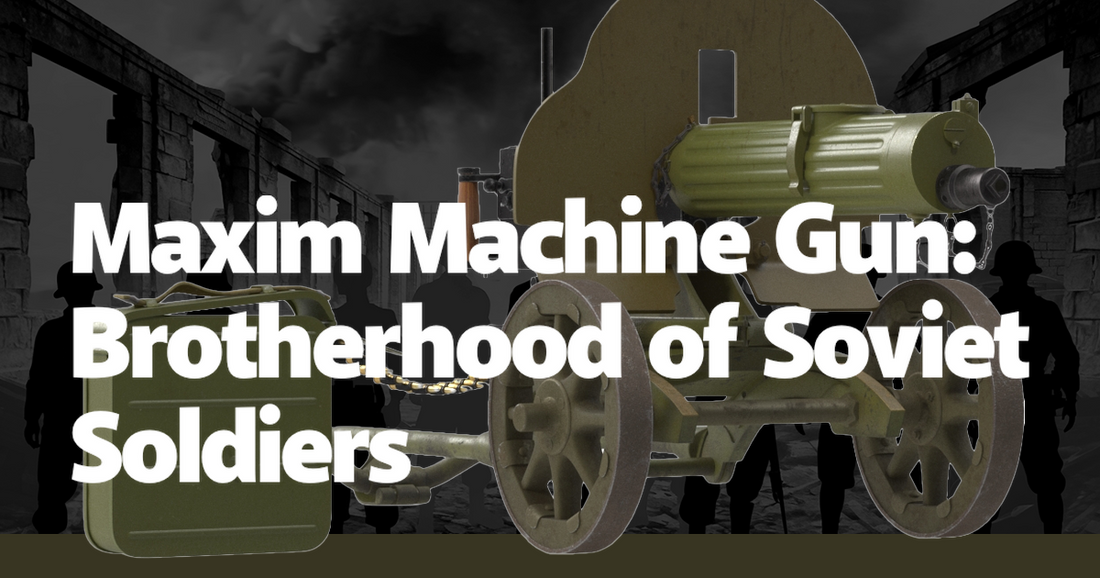In the annals of military history, few weapons have left as indelible a mark as the Maxim machine gun. Developed by Sir Hiram Maxim in the late 19th century, this formidable weapon became a symbol of industrialized warfare. Yet, its story does not end with its invention. The Maxim gun found a second life in the hands of Soviet soldiers, becoming an integral part of the Red Army’s arsenal during some of the most pivotal moments of the 20th century. This relationship between the weapon and its Soviet operators is a tale of brotherhood forged in the crucible of war, where the Maxim was not just a tool but a comrade-in-arms.
The Maxim machine gun was revolutionary for its time, utilizing a recoil-operated firing system that allowed for sustained fire, a significant advantage over the single-shot rifles and manually operated machine guns of the era. When the Soviet Union began to modernize its military in the early 20th century, the Maxim was among the first weapons to be adopted and adapted. The Soviet variant, known as the PM M1910, was mounted on a distinctive wheeled Sokolov mount, making it mobile and versatile. This adaptation was crucial in the sprawling battlefields of the Eastern Front, where mobility and sustained firepower were essential for both offense and defense.
During the Russian Civil War, the Maxim gun became a symbol of the Red Army’s might. Stories abound of Maxim gunners holding the line against overwhelming odds, their barrels glowing red-hot from continuous fire. One such account tells of a young soldier named Ivan, who, during the Battle of Tsaritsyn, manned his Maxim for hours on end, repelling wave after wave of White Army assaults. His comrades described the scene as a “wall of lead,” an impenetrable barrier that turned the tide of battle. Ivan’s story, like many others, exemplifies the relentless spirit of Soviet soldiers and their reliance on the Maxim gun.
The bond between Soviet soldiers and their Maxim guns only grew stronger during World War II. The Eastern Front was a theater of immense brutality and scale, where the Maxim’s reliability and firepower were invaluable. In the Battle of Stalingrad, for example, Maxim guns were set up in strategic positions throughout the city, their operators tasked with defending key points against the relentless German advance. One veteran, Alexei, recalled how his Maxim gun became his lifeline during the siege. “We fed it ammunition like it was bread,” he said, “and it kept us alive.” The Maxim gun’s role in the defense of Stalingrad cannot be overstated; it was a cornerstone of the Soviet strategy to wear down the German forces through sheer attrition.
The Maxim machine gun was not merely a weapon but a symbol of Soviet resilience and ingenuity. The Soviet military engineers made numerous modifications to the original design, improving its cooling system and simplifying its maintenance. These changes made the Maxim even more reliable in the harsh conditions of the Eastern Front, where mud, snow, and extreme temperatures were commonplace. The gun’s ability to function in such adverse conditions earned it the nickname “the soldier’s friend.” This moniker was not given lightly; it was a testament to the trust and reliance that Soviet soldiers placed in their Maxim guns.
The camaraderie between Soviet soldiers and their Maxims extended beyond the battlefield. In the downtime between battles, soldiers would often gather around their Maxim guns, sharing stories and maintaining their weapons. This ritualistic care was both practical and symbolic, a way to ensure the gun’s readiness while also reinforcing the bond between man and machine. One anecdote tells of a group of soldiers who, during a rare lull in the fighting, took turns polishing their Maxim’s brass water jacket until it gleamed. This act of care was a reflection of their respect for the weapon that had saved their lives countless times.
As the war progressed, the Maxim gun continued to prove its worth in various theaters of conflict. From the frozen expanses of Finland during the Winter War to the urban ruins of Berlin, the Maxim was a constant presence. Its distinctive staccato was a sound that both Soviet soldiers and their enemies came to recognize and fear. In the final push towards Berlin, Maxim guns were used to devastating effect in the close-quarters combat that characterized the battle. One soldier, Dmitri, recounted how his unit used their Maxim to clear a fortified building, the gun’s relentless fire cutting through enemy defenses like a scythe through wheat.
The legacy of the Maxim machine gun and its role in the brotherhood of Soviet soldiers is a testament to the enduring power of human ingenuity and resilience. While newer weapons eventually replaced the Maxim in the post-war years, its impact on Soviet military history remains profound. The stories of soldiers like Ivan, Alexei, and Dmitri are a reminder of the weapon’s significance not just as a tool of war, but as a symbol of the unbreakable spirit of those who wielded it. The Maxim machine gun, in the hands of Soviet soldiers, became more than the sum of its parts; it became a legend.

